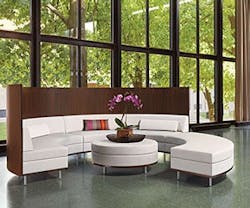Clean + Classic
There are plenty of public seating options on the market, and most of them excel at supporting people in one or two specific settings—an airport, a reception area or collaborative office space, for example. Seldom do you find a collection with the aesthetic and functional flexibility to bridge between all of these different environments. The new Thick & Thin line from Cumberland Furniture represents the rare exception to the rule.
Charlie Kane, design director of XLG Design, designed the seating collection to showcase his firm’s clean and classic aesthetic, while also incorporating Cumberland’s signature blend of stainless steel, wood and upholstery. The result of the pairing is a modern yet timeless system that designers can use to create an architectural environment supported by any setting.
“Any piece we design or manufacture has to reflect the designer and the Cumberland brand,” explains Scott Gilmore, Cumberland’s president. “Our belief is that Cumberland Furniture represents designs that are timeless and classic, yet attainable and tailored to every client. We strive to introduce furniture that is not too trendy, not too modern and not too traditional. Rather, we want pieces that have the ability to adapt to various interior settings.”
Luckily, Kane’s design sensibility goes hand-in-hand with Cumberland’s.
“I’ve always been fond of clean, modernist architecture,” he says. “Except for some K-12 products that I’ve done, everything I have has the same kind of aesthetic. We just kind of meshed between what my aesthetic is and what Cumberland’s is.”
By all accounts, the shared vision and design philosophy allowed for a relatively smooth collaborative process. After a discussion about the end goal being a sectional, Kane sent some drawings to Gilmore. Following a few minor changes, the line was prototyped and released.
“It was a great collaboration and was pretty seamless,” Kane recalls. “It really looks almost exactly like what the original drawings looked like.”
The perks of modern technology also had a hand in the rapid creation of Thick & Thin.
“This wireless and connected world we live in allows us to work together without meeting with one another. For the most part, that was the way this design process happened,” Gilmore says. “I don’t recall Charlie ever visiting our corporate office or factories, nor do I recall ever visiting his office. Truthfully, we didn’t need to. We both shared a common vision and communicated back and forth via phone calls and email. We threw ideas back and forth, listened and observed, and created what we offer today.”
That offering includes nearly 100 different pieces within the Thick & Thin line, all of which are capable of combining in different ways to alter the privacy and interaction within a space. And because the line allows for the differentiation of a space without the addition of hard architecture, it provides a new level of flexibility and affordability to designers and end-users.
“Thick transactional walls provide just enough space to support a laptop or papers during a conversation. Thin walls showcase the amazing warmth and beauty of wood in a minimal space,” Gilmore explains. “Tall walls make for visual privacy for groups and individuals working with them. Shorter walls invite collaboration or input from outside sources. Variable heights and thicknesses combine together to make an architectural environment to support any environment.”
“We enjoy how designers are thinking about the psychological dimension of personal space, personal boundaries, and what gives cues to others who might interrupt or interact,” he continues. “Thick & Thin is a tool for designers to use to create these environments. We would prefer to give designers the freedom to create these environments with few limitations. That is why we created this offering with nearly 100 different pieces.”
To meet the goal of creating a sectional furniture system for collaborative work that combines seating and surfaces with the architectural element of walls of varying heights and thicknesses, Kane drew from several different inspirations.
His first inspiration was how space is being used, and the needs that aren’t currently being met within that space.
“The agenda was to create something that had work spaces and encouraged work, but also had a vocabulary of thresholds and boundaries that was a little bit larger than what we typically see in furniture,” he says.
Another inspiration came from high-backed sofas that weren’t readily specifiable in corporate settings. After considering how people are working today and how to make existing high-backed sofas work within the office environment, Kane created the line to provide cues about how the workspace can be used. The resulting collection includes a wide range of options, including thick or thin arms or backs, and multiple heights (29, 41 and 51 inches), all designed to help create the ultimate collaborative space.
“With Thick & Thin you can send out a variety of visual and physical cues to encourage different levels of collaborative or private workspaces. I think more and more in architecture and in real estate, interior designers are needing more tools to do this without having to rely on hard, physical architecture,” Kane says.
As a long-time veteran of the interior design industry, Kane’s inside knowledge allows him to create products that operate in a way he thinks will be useful for interior designers—even if the designers have yet to realize the need his products fit.
“Charlie is brilliant,” says Gilmore. “He seems to have a good finger on the pulse of what designers need and what the market isn’t currently offering. Charlie is the Steve Jobs of furniture design. We didn’t know we needed iPhones and iPads until they were available and we wondered how we ever lived without them. We feel the same way about Thick & Thin and public space.”
Learn more about the Thick & Thin Collection at www.cumberlandfurniture.com.
Kylie Wroblaski is a former editor for BUILDINGS magazine, and has written previously about architecture and facilities management.
